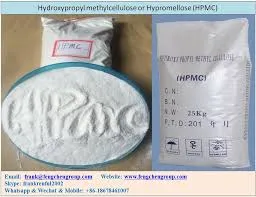
Dec . 14, 2024 23:19 Back to list
hpmc side effects
Understanding HPMC and Its Side Effects
Hydroxypropyl Methylcellulose (HPMC) is a semi-synthetic polymer widely used in various industries, including pharmaceuticals, food, and cosmetics. It serves multiple purposes such as a thickening agent, emulsifier, and film-former. While HPMC is generally recognized as safe, understanding its potential side effects is essential for consumers and healthcare professionals alike.
What is HPMC?
HPMC is derived from cellulose, the most abundant organic polymer on Earth, and undergoes chemical modification. It is commonly used in drug formulations, particularly in oral medications, to control the release of active pharmaceutical ingredients. Additionally, HPMC is a popular ingredient in many food products for its thickening and gelling properties, making it an essential additive in low-calorie and gluten-free formulations.
Common Uses of HPMC
1. Pharmaceuticals HPMC is used in controlled-release tablets and capsules, providing a steady release of medication over time. 2. Food Industry It acts as a stabilizing agent in sauces, dressings, and dairy products, enhancing texture and mouthfeel. 3. Cosmetics In cosmetic formulations, HPMC is utilized for its ability to form a smooth, uniform film, contributing to the overall feel and performance of products.
Potential Side Effects
hpmc side effects

While HPMC is generally safe for most people, some individuals may experience side effects, especially when consumed or applied in large amounts. Below are some potential side effects associated with HPMC
1. Gastrointestinal Issues Some individuals may experience digestive discomfort, including bloating, gas, and diarrhea when consuming products containing HPMC. This is often more pronounced in those with sensitive gastrointestinal tracts.
2. Allergic Reactions Although rare, allergic reactions to HPMC can occur. Symptoms may include skin rashes, itching, or swelling. Individuals with a known sensitivity to cellulose derivatives should exercise caution when using HPMC-containing products.
3. Dry Mouth and Throat HPMC is often employed in dry eye and dry mouth formulations due to its ability to retain moisture. However, in some cases, it can lead to a paradoxical sensation of dryness in the mouth or throat, particularly when used in excessive amounts.
4. Impact on Nutrient Absorption Due to its thickening properties, HPMC may hinder the absorption of certain nutrients or medications. This could be a concern for individuals relying on specific medications or those with dietary restrictions.
Conclusion
HPMC is a versatile and widely-used ingredient with numerous applications across various industries. While the majority of users will not experience any negative side effects, it is crucial to be aware of possible reactions, particularly if you have a history of allergies or gastrointestinal issues. Anyone considering products containing HPMC should consult with healthcare professionals, especially those with existing health conditions or those taking other medications. Understanding the benefits and potential side effects of HPMC can help consumers make informed decisions about its use in food, pharmaceuticals, and personal care products. As always, moderation and awareness are key to safely utilizing any additive in our daily lives.
-
Versatile Hpmc Uses in Different Industries
NewsJun.19,2025
-
Redispersible Powder's Role in Enhancing Durability of Construction Products
NewsJun.19,2025
-
Hydroxyethyl Cellulose Applications Driving Green Industrial Processes
NewsJun.19,2025
-
Exploring Different Redispersible Polymer Powder
NewsJun.19,2025
-
Choosing the Right Mortar Bonding Agent
NewsJun.19,2025
-
Applications and Significance of China Hpmc in Modern Industries
NewsJun.19,2025







